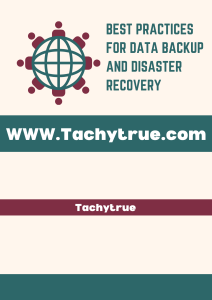Best Practices for Data Backup and Disaster Recovery
Automation, Comunication, cybersecurity, networking, TechnologyIntroduction
In today’s digital landscape, data is one of the most valuable assets for businesses and individuals. Whether it’s customer records, financial documents, or proprietary information, data loss can result in severe consequences, including financial losses, legal issues, and operational downtime. Implementing a solid data backup and disaster recovery (DR) strategy ensures that critical information is protected and can be quickly restored in case of an unexpected event.

This article explores best practices for data backup and disaster recovery to help businesses and individuals safeguard their digital assets effectively.
Understanding Data Backup and Disaster Recovery
What is Data Backup?
Data backup refers to the process of copying and storing data in a separate location to prevent loss due to hardware failure, cyber-attacks, accidental deletion, or natural disasters.
What is Disaster Recovery?
Disaster recovery is a comprehensive strategy that includes processes, policies, and tools to restore IT infrastructure and data in the event of a disaster.
Best Practices for Data Backup
1. Follow the 3-2-1 Backup Rule
One of the most effective backup strategies is the 3-2-1 backup rule:
3 copies of data: One primary and two backups.
2 different storage types: Use a mix of external hard drives, cloud storage, or network-attached storage (NAS).
1 offsite copy: Store one backup in a remote location to protect against natural disasters or cyber threats.
2. Use Automated Backup Solutions
Manual backups are prone to human error and can be easily overlooked. Implementing automated backup solutions ensures that data is regularly backed up without requiring user intervention. Most cloud-based and enterprise-level backup solutions provide automation and scheduling options.
3. Prioritize Critical Data
Not all data is equally important. Classify and prioritize critical data that needs frequent backups, such as customer databases, financial records, and operational documents.
4. Implement Versioning and Incremental Backups
Instead of backing up entire datasets every time, use incremental and differential backups:
5. Encrypt Backups for Security
Cybercriminals often target backup files, so encryption is crucial to protect sensitive information. Use AES-256 encryption for both local and cloud-based backups to ensure data confidentiality.
6. Store Backups in Multiple Locations
Keeping all backups in one place is risky. Store backups in multiple locations, such as:
Local external storage (hard drives, NAS)
Cloud-based solutions (Google Drive, AWS, Microsoft Azure)
Offsite physical locations (for businesses with large data centers)
7. Regularly Test Backups
Regularly test backup files to ensure they are complete, accessible, and not corrupted. Conduct restore drills to verify functionality.
8. Use Cloud Backup Solutions
Cloud-based backup services provide scalability, redundancy, and remote access to data. They also offer built-in security features, such as encryption, multi-factor authentication, and access controls.
9. Establish a Backup Retention Policy
Determine how long backup copies should be retained. Some organizations keep backups for a few weeks, while others require longer retention periods for compliance and legal reasons. Retention policies help manage storage costs and ensure regulatory compliance.
Best Practices for Disaster Recovery
1. Develop a Comprehensive Disaster Recovery Plan
A disaster recovery plan (DRP) outlines the steps needed to restore IT systems and data in case of an incident. It should include:
Roles and responsibilities of team members.
Recovery time objectives (RTO) and recovery point objectives (RPO).
Step-by-step recovery procedures.
2. Implement Redundant Systems
Redundancy ensures that critical systems remain operational even if a failure occurs. Use:
Failover servers to switch to backup systems automatically.
Power backups (UPS systems) to prevent outages.
3. Use Disaster Recovery as a Service (DRaaS)
DRaaS solutions provide cloud-based disaster recovery options, allowing businesses to replicate data and applications in a secure cloud environment. This minimizes downtime and ensures business continuity.
4. Conduct Regular Disaster Recovery Drills
Test your disaster recovery plan regularly to identify weaknesses and areas for improvement. Simulate various disaster scenarios, such as cyber-attacks, hardware failures, and natural disasters, to assess response time and effectiveness.
5. Ensure Cybersecurity Measures Are in Place
Cyber threats, including ransomware and data breaches, can cause significant data loss. Implement strong security practices, such as:
Firewalls and intrusion detection systems.
Multi-factor authentication (MFA).
Regular software updates and patches.
Employee cybersecurity training.
6. Establish Communication Protocols
Clear communication is vital during a disaster. Ensure employees, customers, and stakeholders are informed about the situation and the steps being taken to resolve it. Use multiple communication channels, such as emails, phone calls, and instant messaging platforms.
7. Maintain an Emergency Response Team
Assign a dedicated team responsible for executing the disaster recovery plan. This team should have defined roles and be trained to handle crisis situations efficiently.
8. Implement Virtualization for Quick Recovery
Virtual machines (VMs) allow businesses to quickly restore systems in case of failure. By running multiple virtualized instances on different servers, organizations can ensure faster disaster recovery with minimal downtime.
9. Keep Updated Documentation
Maintain up-to-date documentation of your disaster recovery plan, including changes in infrastructure, software updates, and new security policies. Ensure easy access for authorized personnel.
Conclusion
Data backup and disaster recovery are essential for ensuring business continuity and protecting valuable information. By following best practices such as the 3-2-1 backup rule, encryption, automation, and regular testing, organizations can reduce the risk of data loss. Implementing a comprehensive disaster recovery plan further strengthens resilience against cyber threats, hardware failures, and natural disasters.
Proactive planning and investment in reliable backup and recovery solutions can prevent costly downtime and ensure that businesses remain operational even in the face of unexpected disruptions. Prioritizing data security and disaster preparedness will safeguard digital assets and provide peace of mind in an increasingly interconnected world.
